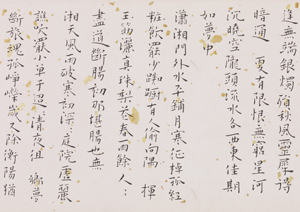Essay
From April to June, 1988, the Yale University Art Gallery held a joint exhibition of C. C. Wang 王季遷 (1907–2004), Wucius Wong 王無邪 (born 1936), Chihung Yang (楊識宏 (born 1947), Keung Szeto 司徒強 (born 1948) and Xing Fei 邢飛 (born 1958), who were living in New York City at that time. Their ink paintings display a cross-cultural sensibility which is seen as “modernizing” Chinese ink painting. Thus, the exhibition was titled Fragrance of the Past. At the request of Yale University Art Gallery Director Mimi Gardner Neill (later Mimi Gardner Gates), Ch’ung-ho Chang Frankel (born 1913) wrote the four-character Chinese title for the small exhibition catalogue in her elegant standard script. Meanwhile, she also wrote the exhibition title with the same characters in large clerical script (lishu 隸書), which was mounted as a hanging scroll, exhibited at Yale and later at the Seattle Art Museum, where it as used as the title work of the 2006 exhibition Fragrance of the Past, Chinese Calligraphy and Paintings by Chang Ch'ung-ho and Friends. In 2010 it was acquired by the Seattle Art Museum.Qianshen Bai ed., Selected Works of Chang Ch’ung-ho’s Poetry, Calligraphy, and Painting (Beijing: SDX Joint Publishing Company, 2010), p.122. Zhang Chonghe shu張充和書, Sun Kangyi 孫康宜ed., Zhang Chonghe tizi xuanji 張充和題字選集 (Hong Kong: Oxford University Press (China) Ltd, 2009): 124-125.
The four monumental characters are thick and strong. The horizontal strokes, as well as the pie 撇 and na捺 strokes, are broad and extend boldly outwards. The brushwork is not simple because the characters feature rounded turns as Chang creates rhythm in the strokes through releasing and exerting pressure on the brush. Moreover, the uneven, rough edges enhance the feeling of power and monumentality that recall the “stele school (beipai 碑派)” tradition of the Qing period (1644–1912), whereby calligraphers simulated stone engravings. Chang followed this tradition because one of her teachers, Zhu Moqin 朱謨欽 (early 20th century) who was a student of Wu Changshi 吳昌碩 (1844–1927), taught her paleography and ancient writing at a young age. Her mentor Shen Yinmo 沈尹默(1883–1971) also urged her to learn clerical script from Han steles, such as Stele of Mount Huashan (Huashan bei華山碑) and Shi Chen at a Sacrificial Service (Shi Chen bei史晨碑).Qianshen Bai, “Shen Yinmo yu Chang Ch’ung-ho” 沈尹默與張充和. In Ch’ung-ho Chang’s collection, Shen Yinmo shuzhong moji沈尹默蜀中墨蹟 (Nanning: Guangxi meishu chubanshe, 2001): 13-14. Chang then combined these classical Han dynasty steles and the calligraphic style of Deng Shiru 鄧石如 (1743–1805) to form her personal style as exemplified by this vertical scroll.Qianshen Bai, “Literati Legacy in the Modern Era: Ch’ung-ho Chang Frankel and Friends,” in Mimi Gardner Gates ed., Fragrance of the Past: Chinese Calligraphy and Painting by Ch’ung-ho Chang Frankel and Friends (Seattle: Seattle Art Museum, 2006): 16-19. The characters “se” (色) and “xiang” (香) derive from bronze and seal scripts.
Moreover, she insists on grinding high quality ancient ink sticks and cakes for use in her calligraphy.Selected Works of Chang Ch’ung-ho’s Poetry, Calligraphy, and Painting: 59. So, the saturation of the ink results in rich, dark strokes of different tonal variation. We can only imagine the effort and time she spent in grinding ink for writing such large characters. Lastly, Chang Ch'ung-ho did not sign her name—instead of an inscription she simply used three carefully placed seals to balance the composition. This allows viewers to focus solely on the four powerful characters.
© 2013 by the Seattle Art Museum
Questions for thought
Answers
| Add an answerAdd Answer:
overview
Chang Ch'ung-ho Frankel張充和
Quick Facts about the Artist
inscriptions and seals
essay
From April to June, 1988, the Yale University Art Gallery held a joint exhibition of C. C. Wang 王季遷 (1907–2004), Wucius Wong 王無邪 (born 1936), Chihung Yang (楊識宏 (born 1947), Keung Szeto 司徒強 (born 1948) and Xing Fei 邢飛 (born 1958), who were living in New York City at that time. Their ink paintings display a cross-cultural sensibility which is seen as “modernizing” Chinese ink painting.
